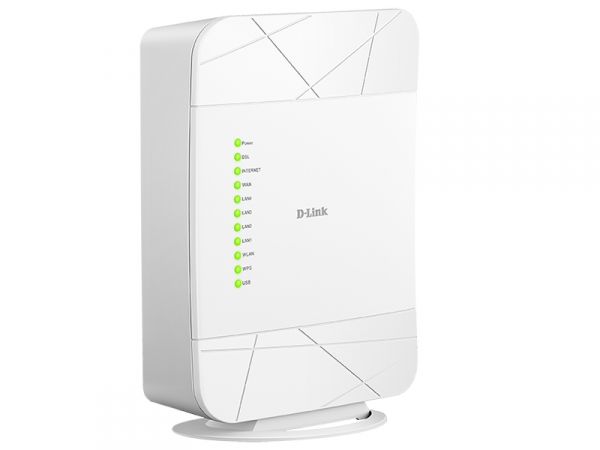
DSL-G225EOL EOS
תאור
USB Port
The router is equipped with a USB port for connecting a USB modem, which can be used to establish connection to the Internet. In addition, to the USB port of the router you can connect a USB storage device, which will be used as a network drive, or a printer.
VDSL Port, 4-port Switch, and Gigabit Ethernet WAN Port
The router is equipped with a VDSL port to connect to a high-speed VDSL line. The built-in 4-port switch enables you to connect Ethernet-enabled computers, game consoles, and other devices to your network. In addition, Gigabit Ethernet WAN port enables you to connect the device to a high-speed Ethernet line.
Wireless Interface
You are able to quickly create a wireless network at home or in your office, which lets your relatives or employees connect to your wireless network virtually anywhere (within the operational range of your wireless network). The router can operate as a base station for connecting wireless devices of the standards 802.11b, 802.11g, and 802.11n.
The router supports multiple functions for the wireless interface: several security standards (WEP, WPA/WPA2), MAC address filtering, and the WPS function.
In addition, the device is equipped with a button for switching the Wi-Fi network off/on. If needed, for example, when you leave home, you can easily switch the router’s WLAN by pressing the button, and devices connected to the LAN ports of the router will stay online.
Security
The wireless router DSL-G225 includes a built-in firewall. The advanced security functions minimize threats of hacker attacks, prevent unwanted intrusions to your network, and block access to unwanted websites for users of your LAN.
Easy configuration and update
You can configure the settings of the wireless router DSL-G225 via the user-friendly web-based interface (the interface is available in several languages).
Now you can simply update the firmware: the router itself finds approved firmware on D-Link update server and notifies when ready to install it.
מאפיינים כללים
Hardware Interfaces
• RJ-11 VDSL port
• 10/100/1000BASE-T WAN port
• 4 10/100BASE-TX LAN ports
• USB 2.0 port
LEDs
• Power
• 4 LAN LEDs
• WLAN
• WPS
• USB
• DSL/WAN
• Internet
Buttons
• SWITCH button to power on/power off
• RESET button to restore factory default settings
• WPS button to set up secure wireless connection
• WLAN button to enable/disable wireless network
Antenna
• Two internal omnidirectional antennas
MIMO
• 2 x 2
Power connector
• Power input connector (DC)
VDSL/ADSL Standards
• VDSL2: ITU G.993.2, support of 8a, 8b, 8c, 8d, 12a, 12b, 17a profiles
• ADSL: Multi-mode, ANSI T1.413 Issue 2, ITU-T G.992.1 (G.dmt) Annex A, ITU-T G.992.2 (G.lite) Annex A, ITU-T G.994.1 (G.hs)
• ADSL2: ITU-T G.992.3 (G.dmt.bis) Annex A/L/M, ITU-T G.992.4 (G.lite.bis) Annex A
• ADSL2+: ITU-T G.992.5 Annex A/L/M
ATM/PPP Protocols
• Bridged and routed Ethernet encapsulation
• VC-based or LLC-based multiplexing
• ATM Forum UNI3.1/4.0 PVC (up to 8 PVCs)
• ATM Adaptation Layer Type 5 (AAL5)
• ITU-T I.610 OAM F4/F5 loopback
• ATM QoS
• PPP over ATM (RFC 2364)
• PPP over Ethernet (PPPoE)
• Keep-alive for PPP connections
WAN connection types
• 3G
• PPPoA
• PPPoE
• IPoA
• Static IP / Dynamic IP
• Bridge
Network functions
• Additional IP address for LAN interface
• DHCP server/relay
• DNS relay
• Dynamic DNS
• Static IP routing
• IGMP Proxy
• IGMP snooping
• RIP
• Support of UPnP IGD
• Support of VLAN
• Support of SIP ALG
• Channel reservation
Firewall functions
• Network Address Translation (NAT)
• Stateful Packet Inspection (SPI)
• IP filter
• MAC filter
• MAC filtering based on time of day and day of week
• URL filter
• DMZ
• Prevention of DoS attacks
• Intrusion detection system
• Virtual servers
• Port Triggering
QoS
• Interface grouping
• VLAN priority (802.1p)
USB interface functions
• USB modem
- Auto connection to available type of supported network (3G/2G)1
- Enabling/disabling PIN code check, changing PIN code2
• USB storage
- Print server
- Access to storage via accounts
- Built-in Samba server
Management
• Local and remote access to settings through TELNET/WEB (HTTP)
• Multilingual web-based interface for configuration and management
• Firmware update via web-based interface
• Automatic notification on new firmware version
• Saving/restoring configuration to/from file
• Support of remote logging
• SNMP agent
• Automatic synchronization of system time with NTP server and manual time/date setup
• Ping function
• TR-069 client
Wireless Module Parameters
Standards
• IEEE 802.11b/g/n
Frequency range
• 2400 ~ 2483.5MHz
Wireless connection security
• WEP
• WPA/WPA2 (Personal)
• МАС filter
• WPS (PBC/PIN)
Advanced functions
• Advanced settings
Wireless connection rate
• IEEE 802.11b: 1, 2, 5.5, and 11Mbps
• IEEE 802.11g: 6, 9, 12, 18, 24, 36, 48, and 54Mbps
• IEEE 802.11n: from 6.5 to 300Mbps (from MCS0 to MCS15)
Transmitter output power
The maximum value of the transmitter output power depends upon the radio frequency regulations applied in your country
• 802.11b (typical at room temperature 25 °C) 16dBm
• 802.11g (typical at room temperature 25 °C) 14dBm
• 802.11n (typical at room temperature 25 °C) 14dBm
Receiver sensitivity
• 802.11b (typical at room temperature 25 °C) -86dBm
• 802.11g (typical at room temperature 25 °C) -72dBm
• 802.11n (typical at room temperature 25 °C):
HT20: -67dBm
HT40: -65dBm



